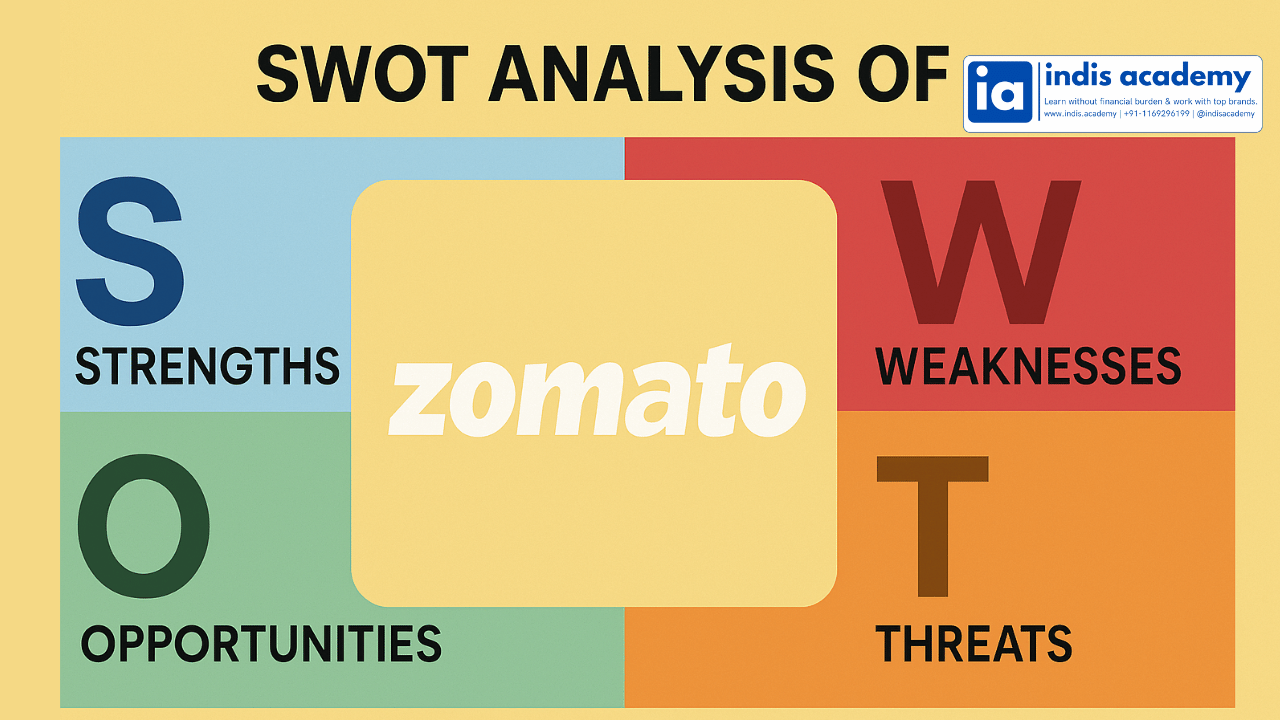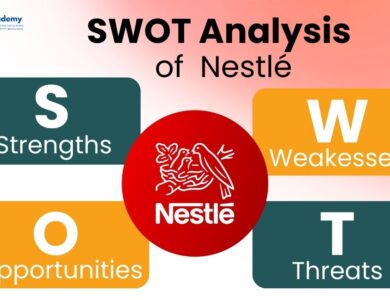Complete SWOT Analysis of Zomato – How It Dominates the Food Delivery Market

Zomato was founded in 2008 by Deepinder Goyal and Pankaj Chaddah as a restaurant discovery platform, initially aimed at helping users find detailed information about local restaurants.
Over the years, Zomato has evolved into a global food delivery platform offering a wide range of services, including restaurant reviews, online food delivery, table reservations, and subscriptions like Zomato Gold.
Headquartered in Gurgaon, India, Zomato operates in over 24 countries, with a particularly strong presence in India, Australia, UAE, and Indonesia.
With 400 million active users globally, Zomato’s app has become the go-to platform for food lovers seeking to explore new dining options or have their meals delivered directly to their doorsteps.
Company Overview – About Zomato
Zomato was founded in 2008 by Deepinder Goyal and Pankaj Chaddah as a restaurant discovery platform, initially aimed at helping users find detailed information about local restaurants.
Over the years, Zomato has evolved into a global food delivery platform offering a wide range of services, including restaurant reviews, online food delivery, table reservations, and subscriptions like Zomato Gold.
Headquartered in Gurgaon, India, Zomato operates in over 24 countries, with a particularly strong presence in India, Australia, UAE, and Indonesia.
With 400 million active users globally, Zomato’s app has become the go-to platform for food lovers seeking to explore new dining options or have their meals delivered directly to their doorsteps.
Key Products and Services:
- Restaurant Discovery & Reviews: Zomato provides detailed reviews, ratings, and menus for thousands of restaurants worldwide, helping consumers make informed dining decisions.
- Food Delivery: The company’s core service, Zomato offers fast, reliable food delivery from a wide variety of restaurants.
- Zomato Gold: A subscription-based loyalty program offering exclusive discounts and benefits at partnered restaurants.
- Zomato Pro: A premium service offering dining benefits at top-tier restaurants.
- Zomato Book: A service for table reservations at selected restaurants.
Zomato’s revenue for FY23 stood at ₹4,199 crore, and the company continues to invest in expanding its offerings in cloud kitchens, online ordering, and fintech solutions like Zomato Payments to stay ahead of competitors like Swiggy and Uber Eats.
What is SWOT Analysis?
A SWOT analysis is a strategic tool used to evaluate the internal and external factors that impact a business. It breaks down the business environment into four key elements:
- S – Strengths: Internal factors that give a company a competitive advantage and enable it to achieve its objectives.
- W – Weaknesses: Internal factors that may hinder the company’s performance or growth, often limiting its ability to compete effectively.
- O – Opportunities: External factors or market conditions that the company can leverage for growth or competitive advantage.
- T – Threats: External factors that could potentially harm the company’s market position, operations, or profitability.
For a dynamic and rapidly evolving company like Zomato, a SWOT analysis helps to assess how well it is leveraging its strengths, addressing weaknesses, capitalizing on opportunities, and preparing for external threats.
It provides critical insights into Zomato’s strategic direction, helping us understand what the future might hold for the company as it competes in an ever-changing food delivery and tech ecosystem.
In this article, we’ll explore how Zomato’s strengths have helped it dominate the food delivery sector, how it can improve on its weaknesses, what opportunities it can capitalize on, and the threats that could disrupt its growth and market share.
Zomato’s Strengths
Zomato’s growth from a restaurant discovery platform to a global leader in food delivery can be attributed to several key strengths that differentiate it from its competitors.
Here’s a closer look at the major strengths that have allowed Zomato to lead in the highly competitive food tech industry:
1. Strong Brand Recognition
Zomato has built a strong brand presence in India and other global markets. The company’s name is almost synonymous with food delivery, making it the first choice for many consumers.
With its extensive advertising campaigns, influencer partnerships, and sponsorships, Zomato has cemented itself as a trusted and reliable brand in the food delivery and restaurant discovery space.
2. User-Friendly App and Technology
Zomato’s mobile app and website are designed for seamless user experiences, providing easy navigation, quick ordering, and real-time tracking of food deliveries.
The company invests heavily in technology, including machine learning, artificial intelligence, and data analytics, to personalize recommendations, optimize delivery times, and forecast demand. This tech-driven approach enhances user satisfaction and operational efficiency.
3. Comprehensive Service Portfolio
Zomato has diversified its offerings far beyond just food delivery. In addition to providing restaurant discovery, online ordering, and dining reservations, Zomato has launched Zomato Gold, a premium subscription offering exclusive discounts and rewards.
The Zomato Pro program provides further loyalty incentives, while Zomato Book enables easy table reservations. This diverse service portfolio ensures that Zomato remains relevant in different aspects of the dining and food experience.
4. Market Leadership and Large Customer Base
Zomato is one of the leading food delivery platforms in India, with over 400 million active users across 24 countries.
Its dominance in India allows it to capitalize on both the growing demand for food delivery and consumer behavior trends like increased online shopping and preference for home deliveries. Zomato’s strong market position gives it competitive pricing power, brand loyalty, and access to a large customer base.
5. Strong Partnerships and Collaborations
Zomato has formed strategic partnerships with major players in the food and tech industries. Collaborations with restaurants, payment platforms, and third-party services help expand Zomato’s reach and services.
These partnerships enable it to offer exclusive deals, restaurant-specific discounts, and more extensive delivery networks. Zomato’s relationships with leading restaurant chains also help ensure a steady supply of restaurant listings and food offerings.
6. International Expansion
Zomato’s expansion into international markets, including Australia, the UAE, and Singapore, has provided a significant growth opportunity.
By catering to different culinary cultures and offering food delivery solutions across diverse regions, Zomato has been able to tap into global food delivery markets. This expansion strengthens its position in the global food tech ecosystem and further diversifies its revenue streams.
These strengths have allowed Zomato to not only dominate the food delivery industry but also innovate and expand in various sectors, ensuring it remains competitive and relevant in an ever-evolving market.
Zomato’s Weaknesses
While Zomato has enjoyed significant success, it also faces some internal challenges that could limit its potential if not addressed. These weaknesses must be considered in order for Zomato to maintain its competitive edge and continue its growth trajectory in the food delivery and tech space.
1. Dependence on the Indian Market
Although Zomato has expanded into several international markets, India remains its primary revenue generator.
This over-reliance on the Indian market makes Zomato vulnerable to economic fluctuations, regulatory changes, or policy shifts that could affect its profitability.
Zomato must work to expand its presence in other markets and ensure that its global footprint is not limited to just a few countries.
2. Thin Profit Margins
Like many companies in the food delivery space, Zomato struggles with thin profit margins. Despite its large user base and market share, the high cost of delivery logistics, marketing, and discount programs can erode profitability.
Zomato heavily depends on subsidies and promotions to attract and retain customers, which impacts its ability to generate sustainable profits in the long term.
3. Quality Control and Operational Challenges
Zomato faces challenges related to quality control and timeliness of deliveries. Since it relies on third-party delivery personnel and restaurant partners, maintaining consistent service quality is a persistent issue.
Delays in food delivery, wrong orders, and quality inconsistencies can lead to customer dissatisfaction and negative reviews, which can tarnish the brand’s reputation.
4. Heavy Reliance on Discounts and Promotions
Zomato has become known for offering deep discounts and attractive promotional deals to attract users. While these offers help grow the user base, they significantly reduce profit margins.
This reliance on price-sensitive promotions may not be sustainable in the long run, and Zomato will need to find ways to shift from being a discount-driven platform to one that can maintain customer loyalty without relying too heavily on promotions.
5. Delivery Logistics and Rising Costs
Despite its vast network, delivery logistics remains a challenge for Zomato. As it scales up, the cost of maintaining delivery fleets, managing traffic congestion, and ensuring timely deliveries can add substantial operational expenses. Moreover, fuel price fluctuations and rising delivery costs could further impact profitability.
Zomato needs to explore cost-effective delivery models to maintain efficiency and reduce expenses.
6. Employee Turnover and Workforce Management
Zomato faces high employee turnover rates, especially among its delivery personnel and support staff. Managing a large and diverse workforce while maintaining service consistency and employee satisfaction is an ongoing challenge.
High turnover can also lead to training costs and service disruptions, impacting the overall user experience.
These weaknesses point to areas where Zomato must focus on cost management, quality control, and workforce stability in order to maintain its competitive advantage. Overcoming these challenges will be crucial for the company’s long-term success.
Zomato’s Opportunities
The food delivery market is rapidly evolving, presenting Zomato with several opportunities to expand its reach, improve its offerings, and stay ahead of the competition.
By capitalizing on emerging trends and technological advancements, Zomato can strengthen its position as a global leader in the food tech industry.
1. Growing Demand for Online Food Delivery
The global food delivery market is growing rapidly, with a significant rise in demand for on-demand services. With millennials and working professionals increasingly seeking convenience and flexibility, Zomato can capitalize on this shift by expanding its reach and offerings.
The demand for home deliveries, contactless services, and meal options for busy consumers continues to rise, especially in urban areas.
2. Expansion into Untapped International Markets
While Zomato has expanded into 24 countries, there are still several emerging markets where food delivery adoption is growing.
Zomato can target South America, Africa, and Southeast Asia for potential expansion. These regions have seen growth in internet penetration and a rise in demand for food delivery services, making them ripe for Zomato to introduce its platform and build its presence.
3. Technology-Driven Innovations
Zomato’s investment in AI, machine learning, and data analytics positions it well to capitalize on technological advancements in the food delivery sector.
With personalized recommendations, automated order processing, and smart delivery optimization, Zomato can enhance its user experience and streamline its operations.
Further advancements in autonomous delivery solutions (like drones and robotic delivery) can help Zomato reduce operational costs and improve delivery speed.
4. Expanding Subscription-Based Services
Zomato has already made significant strides with Zomato Pro and Zomato Gold. By expanding and improving its subscription-based loyalty programs, Zomato can increase customer retention and recurring revenue.
Additional premium services, like exclusive restaurant deals, priority delivery, and curated meal plans, could further differentiate Zomato’s offerings and encourage users to commit to long-term subscriptions.
5. Partnerships with Cloud Kitchens and Small Restaurants
The rise of cloud kitchens (delivery-only restaurants) presents a unique opportunity for Zomato to expand its offerings.
By partnering with cloud kitchen operators and small restaurants, Zomato can diversify its restaurant listings and expand its food delivery capabilities without the overhead costs associated with traditional brick-and-mortar restaurants.
This also provides more options for customers and enhances the variety of food available on the platform.
6. Entry into Grocery Delivery and Meal Kits
With the success of grocery delivery services like BigBasket and Amazon Pantry, Zomato could consider expanding into the grocery segment.
Offering fresh groceries, meal kits, and ready-to-eat meal options could cater to the growing trend of home cooking and health-conscious eating.
By diversifying into grocery delivery and meal prep kits, Zomato can tap into a whole new customer base, further expanding its market share.
7. Increased Focus on Sustainability and Green Initiatives
As consumers become more eco-conscious, there is a growing demand for sustainable practices in all industries.
Zomato can capitalize on this by offering eco-friendly packaging for deliveries, partnering with restaurants that use organic ingredients, and implementing sustainable business practices across its operations.
By aligning itself with environmentally responsible values, Zomato can enhance its brand image and appeal to socially conscious consumers.
By leveraging these opportunities, Zomato can not only expand its market presence but also diversify its offerings, providing more value to its customers and stakeholders.
These strategic moves will ensure that Zomato remains at the forefront of the food tech industry.
Zomato’s Threats
While Zomato is well-positioned for growth, it faces several external threats that could impact its profitability, market share, and long-term sustainability.
The competitive landscape, changing consumer behavior, and economic fluctuations all contribute to the risks Zomato must manage to maintain its market leadership.
1. Intense Competition
Zomato operates in a highly competitive market, with major players like Swiggy, Uber Eats, and new entrants constantly innovating to capture market share.
JioMart, Dunzo, and BigBasket are also expanding into the food delivery space, making it increasingly difficult for Zomato to maintain its leadership position.
The price wars and discount offers in the industry continue to pressure Zomato’s margins, forcing it to adapt quickly and offer competitive services without sacrificing profitability.
2. Rising Delivery Costs
The cost of delivery logistics remains one of Zomato’s most significant challenges. As fuel prices rise and delivery personnel demand higher wages, the cost per delivery increases, directly affecting profitability.
Zomato needs to find cost-effective solutions to mitigate these delivery expenses, or risk facing a deterioration in profit margins. Additionally, traffic congestion and delivery inefficiencies in major cities can slow down service and hurt customer satisfaction.
3. Economic Slowdowns and Consumer Spending Cuts
During periods of economic slowdown or recession, consumers may cut back on discretionary spending, which includes eating out or ordering food online.
Zomato’s business is highly dependent on consumer spending patterns, especially in the urban food delivery market. Economic disruptions, inflation, or rising unemployment could significantly affect demand for food delivery services and hamper growth.
4. Regulatory Risks and Compliance Challenges
The food delivery industry is heavily regulated, especially when it comes to food safety, taxation, and labor laws.
Any changes in government policies, such as new GST regulations, food safety requirements, or data protection laws, could have a significant impact on Zomato’s operations and bottom line.
Additionally, the company’s gig economy model for delivery personnel is under scrutiny, and stricter labor regulations could increase operational costs or force Zomato to adopt more costly employment practices.
5. Changing Consumer Preferences
Consumer preferences in the food industry are rapidly evolving. Increasing health consciousness and awareness about nutritional choices are leading consumers to opt for healthier alternatives such as organic foods, vegetarian and vegan options, or meal-prep kits.
Zomato may face the challenge of adapting its offerings to cater to these shifts in demand. Failure to stay ahead of dietary trends could impact customer loyalty, especially among younger consumers who prioritize health-conscious eating.
6. Data Privacy and Cybersecurity Risks
As a digital-first company, Zomato stores large volumes of personal data from users, restaurants, and delivery personnel.
This makes it a target for cyberattacks, data breaches, or privacy violations. Any security incidents could damage the company’s reputation, erode customer trust, and invite regulatory scrutiny.
Zomato will need to invest in robust cybersecurity measures to safeguard sensitive information and comply with evolving data protection regulations.
These threats highlight the importance of agility, innovation, and strategic risk management for Zomato. To ensure continued success, the company will need to address these challenges through cost optimization, service differentiation, and sustainable growth strategies.
Competitive Strategy & Future Outlook
Zomato has consistently adapted to changing market dynamics and customer preferences.
To maintain its position as a leader in the food delivery space, Zomato must focus on innovation, market diversification, and operational efficiency. Here’s a look at Zomato’s competitive strategy and future outlook:
1. Expansion into New Markets
Zomato has already expanded into 24 countries, but there is still significant potential for growth in emerging markets like South America, Africa, and Southeast Asia.
These regions have rapidly growing urban populations and increasing demand for food delivery services. By tapping into these markets, Zomato can diversify its revenue streams and reduce its reliance on the Indian market.
2. Diversification into Cloud Kitchens and Dark Stores
Zomato has recognized the growing trend of cloud kitchens, which are delivery-only restaurants that eliminate the need for costly real estate.
Partnering with cloud kitchen operators or setting up its own facilities could help Zomato expand its restaurant network while keeping costs low. By investing in dark stores (warehouses for groceries or food products),
Zomato can tap into the grocery delivery and meal kit delivery sectors, diversifying its offerings and attracting new customer segments.
3. Strengthening Zomato Pro and Subscription Models
Zomato’s Zomato Pro and Zomato Gold services offer exclusive rewards, discounts, and access to premium restaurants.
Expanding and improving these subscription models can help increase customer loyalty and provide recurring revenue streams.
Zomato could also introduce tiered memberships with more personalized and exclusive benefits to attract a broader range of customers, from budget-conscious users to premium ones.
4. Emphasis on Technology and Data
Zomato’s strong investment in AI, machine learning, and big data has already given it a competitive edge. By further refining personalized recommendations, order forecasting, and delivery optimization, Zomato can enhance its customer experience and operational efficiency.
Moreover, it can leverage data to introduce dynamic pricing models based on demand, time of day, or location, thereby optimizing revenue per delivery.
5. Sustainability Initiatives
As sustainability becomes a growing priority for both consumers and investors, Zomato has an opportunity to lead in eco-friendly practices.
By focusing on sustainable packaging, promoting green restaurant initiatives, and reducing its carbon footprint through electric delivery vehicles or solar-powered kitchens, Zomato can align itself with the growing trend of corporate social responsibility (CSR) and attract environmentally conscious consumers.
6. Strategic Partnerships and Mergers
To further strengthen its position, Zomato could form strategic partnerships with major players in the food tech and technology sectors.
Collaborations with payment platforms, AI startups, or grocery delivery services could provide Zomato with new tools to enhance its platform and offer more comprehensive services.
Additionally, mergers or acquisitions in emerging food delivery or related tech sectors could help Zomato expand its service offerings and market presence rapidly.
Future Outlook
Zomato is well-positioned for the future, provided it continues to innovate, diversify, and address operational challenges.
With 5G technology set to revolutionize the digital landscape, Zomato can capitalize on faster internet speeds to offer even more seamless and efficient services.
By expanding into new markets, further enhancing its subscription models, and leading in sustainability efforts, Zomato can continue to grow its customer base and increase its market share globally.
However, it will need to navigate price wars, regulatory changes, and rising operational costs while ensuring a premium service experience to stand out from competitors.
Zomato’s ability to diversify into cloud kitchens, meal kit deliveries, and grocery services will also play a crucial role in its ability to sustain growth in an increasingly crowded market.
In conclusion, Zomato’s future success lies in strategic innovation, market diversification, and enhanced customer engagement.
By staying agile and customer-centric, it can continue to dominate the global food delivery industry and carve out new opportunities for growth.
Conclusion & Final Thoughts
Zomato has successfully established itself as a leader in the food delivery market, driven by its strong brand presence, tech-driven solutions, and comprehensive service portfolio.
Its market dominance in India, coupled with strategic expansions into global markets, positions Zomato well for continued growth in the evolving food tech ecosystem.
However, like any company, Zomato faces internal challenges such as profit margin pressures, operational inefficiencies, and over-reliance on India for its revenue.
Addressing these weaknesses and diversifying its service offerings—especially into cloud kitchens, grocery delivery, and premium subscription models—will be crucial for ensuring sustainable growth.
Zomato’s opportunities lie in capitalizing on technological advancements, expanding into untapped international markets, and leading the way in sustainable practices.
At the same time, the company must remain vigilant to external threats like rising competition, economic slowdowns, and data privacy concerns.
With its strategic initiatives aimed at innovation, diversification, and global expansion, Zomato is poised to remain a dominant player in the food delivery market, adapting to changing consumer preferences and competitive pressures.
By continuing to evolve and adapt to the rapid changes in the food tech space, Zomato can sustain its growth and secure its leadership position in the industry.





